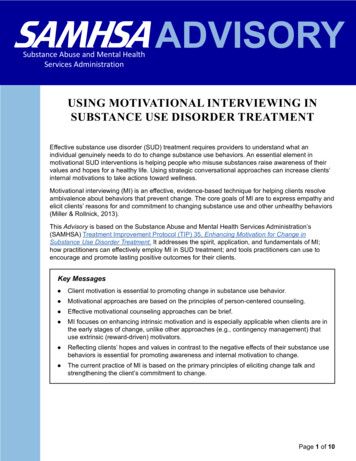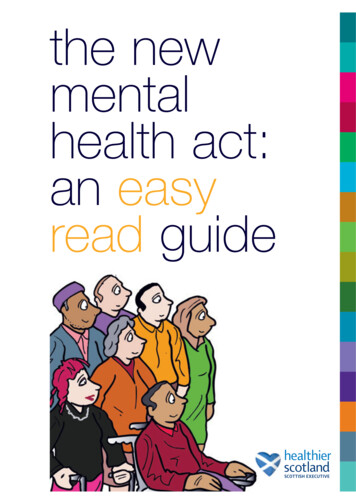
Transcription
Motivational Interviewing
Eight Tasks in Learning Motivational Interviewing1) Overall Spirit of MIOpenness to a way of thinking and working that is collaborative ratherthan prescriptive, honors the client’s autonomy and self-direction, and ismore about evoking than installing. This involves at least a willingness tosuspend an authoritarian role, and to explore client capacity rather thanincapacity, with a genuine interest in the client’s experience andperspectives.2) OARS:Client-CenteredCounseling SkillsProficiency in client-centered counseling skills to provide a supportiveand facilitative atmosphere in which clients can safely explore theirexperience and ambivalence. This involves the comfortable practice ofopen-ended questions, affirmation, summaries, and particularly the skillof accurate empathy as described by Carl Rogers.3) RecognizingChange Talk andSustain TalkAbility to identify client “change talk” and commitment language thatsignals movement in the direction of behavior change, as well as clientsustain talk. Preparatory change talk includes desire, ability, reasons, andneed for change, which favor increased strength of commitment(D.A.R.N).4) Eliciting andStrengtheningChange TalkAbility to evoke and reinforce client change talk and commitmentlanguage. Here the client-centered OARS skills are appliedstrategically, to differentially strengthen change talk and commitment.5) Rolling withSustain Talk andResistanceAbility to respond to client sustain talk and resistance in a manner thatreflects and respects without reinforcing it. The essence is to roll withrather than opposing it.6) Developing aChange PlanMaking the transition into Phase 2 of MI. Ability to recognize clientreadiness, and to negotiate a specific change plan that is acceptable andappropriate to the client. This involves timing as well as negotiationskills.7) ConsolidatingCommitmentAbility to elicit increasing strength of client commitment to change,and to specific implementation intentions.8) Transition andBlendingAbility to blend an MI style with other intervention methods and totransition flexibly between MI and other approaches.
The Spririt of MotivationalInterviewing (MI)Here are some points that are normallyincluded in an introduction to the method andspirit of MI:Ambivalence as a normal step towardchange. (In the transtheoretical model ofchange, this is the contemplation stage.)People can remain stuck in ambivalence for along time.9. Interpreting or analyzing10. Reassuring, sympathizing, or consoling11. Questioning or probing12. Withdrawing, distracting, humoring, orchanging the subjectReactance TheoryReactance is a motivational reaction to offers, persons,rules, or regulations that threaten or eliminate specificbehavioral freedoms. Reactance occurs when a personfeels that someone or something is taking away his or herchoices or limiting the range of alternatives.Purpose of MI: For the specific purpose ofhelping people to move toward change byworking through ambivalence.Psychological reactance occurs in response to threats toperceived behavioral freedoms. An example of suchbehavior can be observed when an individual engages in aprohibited activity in order to deliberately taunt theDefinition of MI: A person-centered, goaldirected counseling method for helpingpeople to change by working throughambivalence.authority who prohibits it, regardless of the utility ordisutility that the activity confers. An individual'sfreedom to select when and how to conduct theirbehavior, and the level to which they are aware of therelevant freedom and are able to determine behaviorsThree aspects of the underlying spirit of MI:Collaboration, Evocation, AutonomySupportnecessary to satisfy that freedom affect the generation ofpsychological reactance. It is assumed that if a person'sbehavioral freedom is threatened or reduced, they becomemotivationally aroused. The fear of loss of furtherFour principles of MI: Empathy,Discrepancy, Resistance, Self-Efficacyfreedoms can spark this arousal and motivate them to reestablish the threatened freedom. Because thismotivational state is a result of the perceived reduction ofone's freedom of action, it is considered a counterforce,Twelve Roadblocks to Listeningand thus is called "psychological reactance".1. Ordering, directing, or commanding2. Warning or threatening3. Giving advice, making suggestions, orproviding solutions4. Persuading with logic, arguing, or lecturing5. Moralizing, preaching, or telling clientswhat they "should" do6. Disagreeing, judging, criticizing, orblaming7. Agreeing, approving, or praising8. Shaming, ridiculing, or labelingThere are four important elements to reactance theory:perceived freedom, threat to freedom, reactance, andrestoration of freedom. Freedom is not an abstractconsideration, but rather a feeling associated with realbehaviors, including actions, emotions, and attitudes.Reactance also explains denial as it is encountered inaddiction counselling. According to William R. Miller,"Research demonstrates that a counselor can driveresistance (denial) levels up and down dramaticallyaccording to his or her personal counseling style". Use ofa "respectful, reflective approach" described in
motivational interviewing and applied as motivationenhancement therapy, rather than by argumentation, theWith a given set of free behaviors, the greater theaccusation of "being in denial", and direct confrontations,proportion threatened or eliminated, the greater will belead to the motivation to change and avoid the resistancethe total level of reactance.and denial, or reactance, elicited by strong directconfrontation.When an important free behavior has been threatenedwith elimination, the greater will be the threat, and theReactance can occur when someone is heavily pressuredgreater will be the level of reactance.to accept a certain view or attitude. Reactance can causethe person to adopt or strengthen a view or attitude thatWhen there is a loss of a single free behavior, there mayis contrary to what was intended, and also increasesbe by implication a related threat of removal of other freeresistance to persuasion. People using reverse psychologybehaviors now or in the future.are playing on at least an informal awareness of reactance,attempting to influence someone to choose the oppositeA free behavior may be threatened or eliminated by virtueof what they request.of the elimination (or threat of elimination) of anotherfree behavior; therefore a free behavior may be threatenedReactance theory assumes there are "free behaviors"by the relation of the elimination of (or threat to) anotherindividuals perceive and can take part in at any givenperson's free behavior.moment. For a behavior to be free, the individual musthave the relevant physical and psychological abilities topartake in it, and must know they can engage in it at themoment, or in the near future."Behavior" includes any imaginable act. More specifically,behaviors may be explained as "what one does (or doesn'tdo)", "how one does something", or "when one doessomething". It is not always clear, to an observer, or theindividuals themselves, if they hold a particular freedomto engage in a given behavior. When a person has such afree behavior they are likely to experience reactancewhenever that behavior is restricted, eliminated, orthreatened with elimination.There are several rules associated with free behaviors andreactance: When certain free behaviors are threatened orremoved, the more important a free behavior is to acertain individual the greater the magnitude of thereactance.The level of reactance has a direct relationship to theimportance of the eliminated or threatened behavioralfreedom, in relationship to the importance of otherfreedoms at the time.
Motivational Interviewing Strategies andTechniques: Rationales and Examples ata glance:ASKING PERMISSIONRationale: Communicates respect for clients. Also,clients are more likely to discuss changing whenasked, than when being lectured or being told tochange.Examples of Asking Permission “Do you mind if we talk about [insert behavior]?” “Can we talk a bit about your [insert behavior]?” “I noticed on your medical history that you havehypertension, do mind if we talk about howdifferent lifestyles affect hypertension?” (Specificlifestyle concerns such as diet, exercise, and alcoholuse can be substituted for the word“lifestyles” in this sentence.)OPENED-ENDED QUESTIONS “What brought you here today?” “What happens when you behave that way?” “How were you able to not use [insert substance]for [insert time frame]?” “Tell me more about when this first began.” “What’s different for you this time?” “What was that like for you?” “What’s different about quitting this time?”REFLECTIVE LISTENINGRationale: Reflective listening is the primary way ofresponding to clients and of building empathy.Reflective listening involves listening carefully toclients and then making a reasonable guess aboutwhat they are saying; in other words, it is likeforming a hypothesis. The therapist thenparaphrases the clients’ comments back to them (e.g.,“It sounds like you are not ready to quit smokingcigarettes.”).Another goal in using reflective listening is to getclients to state the arguments for changeRationale: When therapists use open-ended(i.e., have them give voice to the change process),questions it allows for a richer, deeper conversationrather than the therapist trying to persuade orthat flows and builds empathy with clients. Inlecture them that they need to change (e.g., “So, youcontrast, too many back-to-back closed- ordeadended questions can feel like an interrogation (e. are saying that you want to leave your husband, andon the other hand, you worry about hurting hisg., “How often do you use cocaine?” “How manyyears have you had an alcohol problem?” “How many feelings by ending the relationship.\times have you been arrested?”).That must be difficult for you. How do you imagineOpen-ended questions encourage clients to do most the two of you would feel in 5 years if things remainthe same?”). Reflections also validate what clients areof the talking, while the therapist listens andfeeling and doing so communicates that the therapistresponds with a reflection or summary statement.understands what the client has said (i.e., “It soundsThe goal is to promote further dialogue that can belike you are feeling upset at not getting the job.”).reflected back to the client by the therapist. OpenWhen therapists’ reflections are correct, clientsended questions allow clients to tell their stories.usually respond affirmatively. If the guess is wrong(e.g., “It sounds like you don’t want to quit smokingExamples of Open-Ended Questionsat this time.”), clients usually quickly disconfirm the “Tell me what you like about your [inserthypothesis (e. g. “No, I do want to quit, but I am veryrisky/problem behavior].”dependent and am concerned about major “What’s happened since we last met?”withdrawals and weight gain.”). “What makes you think it might be time for achange?”
Examples of Reflective Listening (generic) “It sounds like .” “What I hear you saying ” “So on the one hand it sounds like . And, yet onthe other hand .” “It seems as if .” “I get the sense that .” “It feels as though .”Examples of Reflective Listening (specific) “It sounds like you recently became concernedabout your [insert risky/problem behavior].” “It sounds like your [insert risky/problem behavior]has been one way for you to [insertwhatever advantage they receive].” “I get the sense that you are wanting to change, andyou have concerns about [insert topic orbehavior].” “What I hear you saying is that your [insertrisky/problem behavior] is really not much of aproblem right now. What you do think it might takefor you to change in the future?” “I get the feeling there is a lot of pressure on you tochange, and you are not sure you cando it because of difficulties you had when you triedin the past.”ELICITING/EVOKING CHANGE TALKRationale: Change talk tends to be associated withsuccessful outcomes. This strategy elicits reasons forchanging from clients by having them give voice tothe need or reasons for changing.Rather than the therapist lecturing or telling clientsthe importance of and reasons why they shouldchange, change talk consists of responses evokedfrom clients. Clients’ responses usually containreasons for change that are personally important forthem. Change talk, like severalMotivationalInterviewing (MI) strategies, can beused to address discrepancies between clients’ wordsand actions (e.g., saying that they want to becomeabstinent, but continuing to use) in a manner that isnonconfrontational. One way of doing this is shownlater in this table under the Columbo approach.Importantly, change talk tends to be associated withsuccessful outcomes.Questions to Elicit/Evoke Change Talk “What would you like to see different about yourcurrent situation?” “What makes you think you need to change?” “What will happen if you don’t change?” “What will be different if you complete yourprobation/referral to this program?” “What would be the good things about changingyour [insert risky/problem behavior]?” “What would your life be like 3 years from now ifyou changed your [insert risky/problembehavior]?” “Why do you think others are concerned aboutyour [insert risky/problem behavior]?”Elicit/Evoke Change Talk For Clients Having DifficultyChanging: Focus is on being supportive as the clientwants to change but is struggling. “How can I help you get past some of thedifficulties you are experiencing?” “If you were to decide to change, what would youhave to do to make this happen?”Elicit/Evoke Change Talk by Provoking Extremes: Foruse when there is little expressed desire for change.Have the client describe a possible extremeconsequence. “Suppose you don’t change, what is the WORSTthing that might happen?” “What is the BEST thing you could imagine thatcould result from changing?”Elicit/Evoke Change Talk by Looking Forward: Thesequestions are also examples of how to deploydiscrepancies, but by comparing the current situationwith what it would be like to not have the problemin the future.
“If you make changes, how would your life bedifferent from what it is today?” “How would you like things to turn out for you in2 years?”EXPLORING IMPORTANCE AND CONFIDENCE. THEREADINESS TO CHANGE RULERRationale: As motivational tools, goal importanceand confidence ratings have dual utility: (a) theyprovide therapists with information about howclients view the importance of changing and theextent to which they feel change is possible, and (b)as with other rating scales (e.g., Readiness toChange Ruler), they can be used to get clients togive voice to what they would need to do tochange.Examples of How to Explore Importance andConfidence Ratings “Why did you select a score of [insert #] on theimportance/confidence scale rather than [lower #]?” “What would need to happen for yourimportance/confidence score to move up from a[insert #] to a [insert a higher #]?” “What would it take to move from a [insert #] to a[higher #]?” “How would your life be different if you movedfrom a [insert #] to a [higher #]?” “What do you think you might do to increase theimportance/confidence about changing your[insert risky/problem behavior]?”NORMALIZINGRationale: Normalizing is intended to communicateto clients that having difficulties while changing isnot uncommon, that they are not alone in theirexperience, or in their ambivalence about changing.Normalizing is not intended to make clients feelcomfortable with not changing; rather it is to helpthem understand that many people experiencedifficulty changing.Examples of Normalizing “A lot of people are concerned about changing their[insert risky/problem behavior].” “Most people report both good and less goodthings about their [insert risky/problembehavior].” “Many people report feeling like you do. They wantto change their [insert risky/problembehavior], but find it difficult.” “That is not unusual, many people report havingmade several previous quit attempts.” “A lot of people are concerned about gainingweight when quitting.”DECISIONAL BALANCINGRationale: Decisional balancing strategies can beused anytime throughout treatment. A goodstrategy is to give clients a written DecisionalBalance (DB) exercise at the assessment session andask them to bring the completed exercise to theirfirst session. The DB exercise asks clients to evaluatetheir current behaviors by simultaneously looking atthe good and less good things about their actions.The goal for clients is two fold: To realize that (a)they get some benefits from their risky/problembehavior, and (b) there will be some costs if theydecide to change their behavior. Talking withclients about the good and less good things theyhave written down on their DB can be used to helpthem understand their ambivalence about changingand to move them further toward wanting to change.Lastly, therapists can do a DB exercise with clientsby simply asking them in an openended fashionabout the good and less good things regarding theirrisky/problem behavior and what it would take tochange their behavior.Examples of How to Use a Decisional Balance Exercise “What are some of the good things about your[insert risky/problem behavior]? [Client answers]Okay, on the flipside, what are some of the less goodthings about your [insert risky/problem behavior].”
After the clients discuss the good and less goodthings about their behavior, the therapist can use areflective, summary statement with the intent ofhaving clients address their ambivalence aboutchanging. “On the one hand you’re coughing and are outbreath, and on the other hand you are sayingcigarettes are not causing you any problems. Whatdo you think is causing your breathingdifficulties?”DEVELOPING DESCREPANCY & THE COLUMBOAPPROACH “So, help me to understand, on the one hand yousay you want to live to see your 12-yearold daughter grow up and go to college, and yet youwon’t take the medication your doctorprescribed for your diabetes. How will that help youlive to see your daughter grow up?”Rationale: The Columbo approach can also becharacterized as deploying discrepancies. The goal isto have a client help the therapist make sense of theclient’s discrepant information The approach takes itsname from the behavior demonstrated by Peter Falkwho starred in the 1970s television series Columbo.The Columboesque approach is intended as a curiousinquiry about discrepant behaviors without beingjudgmental or blaming and allows for thejuxtaposing in a nonconfrontational manner ofinformation that is contradictory. In other words, itallows the therapist to address discrepancies betweenwhat clients say and their behavior without evokingdefensiveness or resistance. “Help me understand, on the one hand I hear yousaying you are worried about keeping the custody ofyour children. Yet, on the other hand you are tellingme that you are using crack occasionally with yourboyfriend. Since you also told me you are being drugscreened on a random basis, I am wondering howusing cocaine might affect your keeping custody ofyour children.”STATEMENTS SUPPORTING SELF-EFFICACYDeveloping Discrepancy:When deploying discrepancies, when possible, asshown in the example below try to end the reflectionon the side of change as clients are more likely toelaborate on the last part of thestatement. “It sounds like when you started using cocainethere were many positives. Now, however, itsounds like the costs, and your increased use coupledwith your girlfriend’s complaints,have made you think about quitting. What will yourlife be like if you do stop?”Examples of How to Use the Columbo Approach:While the following responses might sound a bitunsympathetic, the idea is to get clients who presentwith discrepancies to recognize them rather thanbeing told by their therapists that what they aresaying does not make sense.Rationale: Eliciting statements that support selfefficacy (self-confidence) is done by having clientsgive voice to changes they have made. Because manyclients have little self-confidence in their ability tochange their risky/problem behaviors, the objective isto increase their selfconfidence that they can change.Self-confidence statements can be sought fromclients using scaling techniques (e. g, Readiness toChange Ruler, Importance and Confidence relatedto goal choice).For example, when using a Readiness Ruler, if clients’readiness to change goes from a lower number (past)to a higher number (now), therapists may follow-upby asking how they were able to do that and howthey feel about their change.
Examples of Eliciting Statements Supporting SelfEfficacy “It seems you’ve been working hard to quitsmoking. That is different than before. How haveyou been able to do that?” “Last week you were not sure you could go one daywithout using cocaine, how were you ableto avoid using the entire past week?” “So even though you have not been abstinent everyday this past week, you have managed to cutyour drinking down significantly. How were you ableto do that?” “Based on your self-monitoring logs, you have notbeen using cannabis daily. In fact, you onlyused one day last week. How were you able to dothat?” Follow-up by asking, “How do you feelabout the change?”After asking about changes clients have made, it isimportant to follow-up with a question abouthow clients feel about the changes they made. “How do you feel the changes you made?” “How were you able to go from a [# 6 months ago]to a [# now]?” [Client answers] “How doyou feel about those changes?”READINESS TO CHANGE RULERRationale: Assessing readiness to change is a criticalaspect of MI. Motivation, which is considered a statenot a trait, is not static and thus can change rapidlyfrom day to day. Clients enter treatment at differentlevels of motivation or readiness to change (e.g., notall are ready to change; many are ambivalent aboutchanging). In this regard, if therapists know whereclients are in terms of their readiness to change, theywill be better prepared to recognize and deal with aclient’s motivation to change. The concept ofreadiness to change is an outgrowth of the Stages ofChange Model that conceptualizes individuals asbeing at different stages of change when enteringtreatment. While readiness to change can beevaluated using the Stages of Change Model, asimpler and quicker way is to use a Readiness toChange Ruler.This scaling strategy conceptualizes readiness ormotivation to change along a continuum and asksclients to give voice to how ready They are to changeusing a ruler with a 10-point scale where 1 definitely not ready to change and 10 definitelyready to change. A Readiness Ruler allows therapiststo immediately know their client’s level ofmotivation for change. Depending on where theclient is, the subsequent conversation may takedifferent directions. The Readiness to Change Rulercan also be used to have clients give voice to howthey changed, what they need to do to changefurther, and how they feel about changing.Examples of How to Use a Readiness to Change Ruler Therapist (T): “On the following scale from 1 to 10,where 1 is definitely not ready to change and 10 isdefinitely ready to change, what number best reflectshow ready you are at the present time to change your[insert risky/problem behavior]?”Client (C): “Seven.”T: “And where were you 6 months ago?”C: “Two.”T: “So it sounds like you went from not being readyto change your [insert risky/problembehavior] to thinking about changing. How did yougo from a ‘2’ 6 months ago to a ‘7’ now?” “How do you feel about making those changes?” “What would it take to move a bit higher on thescale?”Clients with lower readiness to change (e.g., answersdecreased from a “5” 6 months ago to a“2” now) “So, it sounds like you went from being ambivalentabout changing your [insert risky/problem behavior]to no longer thinking you need to change your[insert risky/problem behavior]. How did you gofrom a ‘5’ to a ‘2’?” “What one thing do you think would have tohappen to get you to back to where you were 6months ago?”
AFFIRMATIONSRationale: Affirmations are statements made bytherapists in response to what clients have said,and are used to recognize clients’ strengths, successes,and efforts to change. Affirmative responses orsupportive statements by therapists verify andacknowledge clients’ behavior changes andattemptsto change. When providing an affirmation, therapistsshould avoid statements that soundoverlyingratiating (e.g., “Wow, that’s incredible!” or “That’sgreat, I knew you could do it!”).While affirmations help to increase clients’confidence in their ability to change, they also needtosound genuine.Example of Affirmative Statements “Your commitment really shows by [insert areflection about what the client is doing].” “You showed a lot of [insert what best describes theclient’s behavior—strength, courage,determination] by doing that.” “It’s clear that you’re really trying to change your[insert risky/problem behavior].” “By the way you handled that situation, you showeda lot of [insert what best describes theclient’s’ behavior—strength, courage,determination].” “With all the obstacles you have right now, it’s[insert what best describes the client’sbehavior—impressive, amazing] that you’ve beenable to refrain from engaging in [insertrisky/problem behavior].” “In spite of what happened last week, your comingback today reflects that you’reconcerned about changing your [insert : A frequently used MI strategy isproviding advice or feedback to clients. This is avaluable technique because clients often have eitherlittle information or have misinformation abouttheir behaviors. Traditionally, therapists and otherhealth care practitioners have encouraged clientsto quit or change behaviors using simple advice [e.g.,“If you continue using you are going to have(insert health consequence).”]. Research has shownthat by and large the effectiveness of simpleadvice is very limited (e.g., 5% to 10% of smokers arelikely to quit when simply told to quit becausesmoking is bad for their health). The reason simpleadvice does not work well is because most people donot like being “told what to do.” Rather, mostindividuals prefer being given choices in makingdecisions, particularly changing behaviors.What we have learned from MI is that howinformation is presented can affect how it is received.When relevant, new information should bepresented in a neutral, nonjudgmental, and sensitivemanner that empowers clients to make moreinformed decisions about quitting or changing arisky/problem behavior. One way to do this is toprovide feedback that allows clients to compare theirbehavior to that of others so they know how theirbehavior relates to national norms (e.g., percentageof men and women drinking at different levels;percentage of population using cannabis in the lastyear; see Appendices 4.2c and 4.2d for examples ofsuch feedback). Presenting personalized feedback ina motivational manner allows clients to evaluate thefeedback for personal relevance (“I guess I drink asmuch as my friends, but maybe we are all drinkingmore than we should.”).When therapists ask clients what they know abouthow their risky/problem behavior affects otheraspects of their life (e.g., health—hypertension)clients typically say, “Well not much” or they mightgive one or two brief facts. This can be followed-upby asking if they are interesting in learning moreabout the topic and then being prepared to providethem with relevant advice feedback material that thetherapist has prepared or has available. Lastly,
whenever possible, focus on the positives ofchanging. A good example of providing positiveinformation about changing is evident with smoking.Within 20 minutes of stopping smoking an exsmoker’s body begins a series of changes rangingfrom an immediate decrease in blood pressure to 15years after quitting the risk of coronary heart diseaseand death returns to nearly that of those who havenever smoked[http://www.lungusa.org/site/pp.asp?c dvLUK9O0E&b 33568].What is interesting with this example is that manysmokers are not aware of the multiple benefits thatoccur soon after quitting.In this regard, therapists can ask, “What do youknow about the benefits of quitting smoking?” andfollow-up with asking permission to talk about theclient’s smoking (“Do you mind if we spend a fewminutes talking about your smoking?”).Remember that some clients will not wantinformation. In these cases, if the therapist usesscare tactics, lectures, moralizes, or warns ofdisastrous consequences, most clients are not likelyto listen or will pretend to agree in order to not befurther attacked.Examples of How to Provide Advice/Feedback (oftenthis can start by asking permission to talkabout the client’s behavior) “Do you mind if we spending a few minutes talkingabout .? [Followed by] “What do youknow about .?” [Followed still by] “Are youinterested in learning more about .?”[After this clients can be provided with relevantmaterials relating to changing theirrisky/problem behavior or what affects it has onother aspects of their life.] “What do you know about how your drinkingaffects your [insert health problem]?” “What do you know about the laws and what willhappen if you get a second drunk drivingarrest?” “Okay, you said that the legal limit for drunkdriving is 0.08%. What do you know abouthow many drinks it takes to get to this level?” “So you said you are concerned about gainingweight if you stop smoking. How much doyou think the average person gains in the first yearafter quitting?” “I’ve taken the information about your drinkingthat you provided at the assessment,calculated what you report drinking per week onaverage, and it is presented on this formalong with graphs showing levels of drinking in thegeneral p
motivational state is a result of the perceived reduction of one's freedom of action, it is considered a counterforce, and thus is called "psychological reactance". There are four important elements to reactance theory: perceived freedom, threat to freedom, reactanc










